
Human-Centric
Digital Transformation

Content
Chapter 1
Chapter 2
Chapter 3
Human-Centric Digital Transformation -Introduction

Human-Centric Digital Transformation Introduction
What is Human-Centric Digital Transformation?
Human-Centric Digital Transformation Definition
Digital Transformation is about People and Learning
Human-Centric Digital Transformation Strategy
Human-Centric Digital Transformation Framework
Human-Centric Digital Transformation Process - Running Experiments
Human-Centric Digital Transformation Examples
Human-Centric Digital Transformation Introduction
Marc Andreessen famously said that:
Software is eating the world.
Yet, in this guide on Digital Transformation, we are going to tell you to stop updating your hardware and instead focus on updating your wetware.
Your people, their minds, their decision-making power, data literacy and digital literacy are what will empower your Digital Transformation.
Rather than investing in cloud computing, AI and other change programmes, invest in upgrading your people and their decision-making abilities.
Our definition differs from others, in that we see digital transformation as a people led process.
You’ve read over 100 articles on Digital Transformation over the past 10 years. Reports, business books, consulting pitches. In fact, digital transformation has been with us for nearly 30 years already.
You know that digital transformation is key to a competitive advantage in the modern business world. And even more so given the impact of COVID-19. But how has it changed over time?
And what actually is digital transformation? How has a term that has become so widely used, and of such importance, become so hard to define? And how do you go about successfully implementing a digital transformation for your organisation?
Here we outline what digital transformation is, and provide our vision for how you can succeed in your digital transformation by suggesting something radically different to what everyone else is telling you.
That digital transformation starts with your people. And learning is the key to unlocking digital transformation success.
Investing in learning and building capabilities is the highest, predictable long term ROI investment you can make and foundational for your digital transformation. Almost all companies are not investing enough in upgrading the digital decision-making power of their leaders and teams.
People are the key to your digital transformation success, not technology, as others may tell you. Here we tell you why and what to do about it.
What is Human-CentricDigital Transformation?

Human-Centric Digital Transformation Introduction
What is Human-Centric Digital Transformation?
Human-Centric Digital Transformation Definition
Digital Transformation is about People and Learning
Human-Centric Digital Transformation Strategy
Human-Centric Digital Transformation Framework
Human-Centric Digital Transformation Process - Running Experiments
Human-Centric Digital Transformation Examples
What is Human-Centric Digital Transformation?
Because the term ‘Digital Transformation’ means different things to different businesses, it resists a universal definition. With some organisations further along the road than others, and start-ups benefiting from the fact that they start afresh and have no need to transform legacy systems. There is no one size fits all solution. Automating a factory looks very different from automating sales flows for an e-commerce company.
In short, however, digital transformation is an evolution of your business into the digital age. Incorporating digital technology into all areas of your business to leverage value for your customers. Rethinking old structures and processes, and changing how you work. Your mindset. To become more agile, innovative, data-led, and importantly, open to learning.
Digital transformations are hard. Most fail.
We all know that even a small scale change is hard. Yet, digital transformations tend to be large in scope (in 8 out of 10 cases), covering whole organisations. And large scale change is the hardest of all.
According to McKinsey, only 16 per cent of organisations’ digital transformations were a success and equipped them to sustain change in the long term. With an additional 7 per cent saying that performance improved but those improvements were not sustained in the long term.
And it follows that success rates vary by company size. Organisations with fewer than 100 employees are 2.7 times more likely to report a successful digital transformation than organisations with over 50,000 employees.
It is estimated that of the $1.3 trillion that was spent on digital transformation in 2019, $900 billion went to waste.
The reason being that whilst digital tools and technology provide possibilities for gains in efficiency and productivity if most people do not have the mindset or skills to enable change, or processes are flawed, the programme is destined to fail.
Existing flaws only become enlarged.
The Anatomy of Digital:
The tools and technologies that are generally utilised in digital transformations are shown below:

And while research shows that successful transformation efforts involve more numerous and complex digital tools like machine learning and big data architecture, the fact remains, that without a well-built foundation in human skills and capabilities, this would not be possible.
Human-Centric Digital Transformation Definition

Human-Centric Digital Transformation Introduction
What is Human-Centric Digital Transformation?
Human-Centric Digital Transformation Definition
Digital Transformation is about People and Learning
Human-Centric Digital Transformation Strategy
Human-Centric Digital Transformation Framework
Human-Centric Digital Transformation Process - Running Experiments
Human-Centric Digital Transformation Examples
Human-Centric Digital Transformation Definition
In one line:
Digital transformation is a human-led, tech-enabled, customer-centric process of continuous learning.
In a paragraph:
Digital transformation is the meeting point between human skills and capabilities, and the opportunity provided by digital technology and tools to increase value for customers. Where bits and biology meet. It is a continuous process of learning and unlearning, experimentation, adopting new processes, ways of working and mindset to thrive under continual change. It is human-led, tech-enabled, and customer-centric. A process of continuous evolution.
Our definition differs from others, in that we see digital transformation as a people led process.
Whereas, others focus on technology and tools. We realise that technology and tools are nothing without people and their skills behind them.
Digital Transformation is aboutPeople & Learning

Human-Centric Digital Transformation Introduction
What is Human-Centric Digital Transformation?
Human-Centric Digital Transformation Definition
Digital Transformation is about People and Learning
Human-Centric Digital Transformation Strategy
Human-Centric Digital Transformation Framework
Human-Centric Digital Transformation Process - Running Experiments
Human-Centric Digital Transformation Examples
Digital Transformation is about People & Learning
We live in a knowledge economy, where knowledge is our greatest resource. Yet, technology is progressing faster than human capabilities and knowledge are. The tools and technology at our disposal are becoming exponentially more powerful. The result: a digital skills gap.
Digital Skills Gap:

“The illiterate of the 21st century will not be those who cannot read and write, but those who cannot learn, unlearn, and relearn.”
— Alvin Toffler
Despite the gap between skills and technology, a report by Bersin found that among more than 700 organizations studied, the average employee had only 24 minutes a week for deliberate learning.
Digital transformation efforts are destined to fail without investment in people and learning. Technology and tools empower digital transformation, but they are not at the foundation. People are.
The digital skills gap may seem daunting. Yet, you don’t need to fill it. You just need to be ahead of your competitors to reap the benefits.
Once you realise the people and deliberate learning are the foundation of digital transformation and unlocking customer value, you are on the path to success.
Transformation Pyramid:
If we look at the traditional approach to Digital Transformation, it looks something like this:
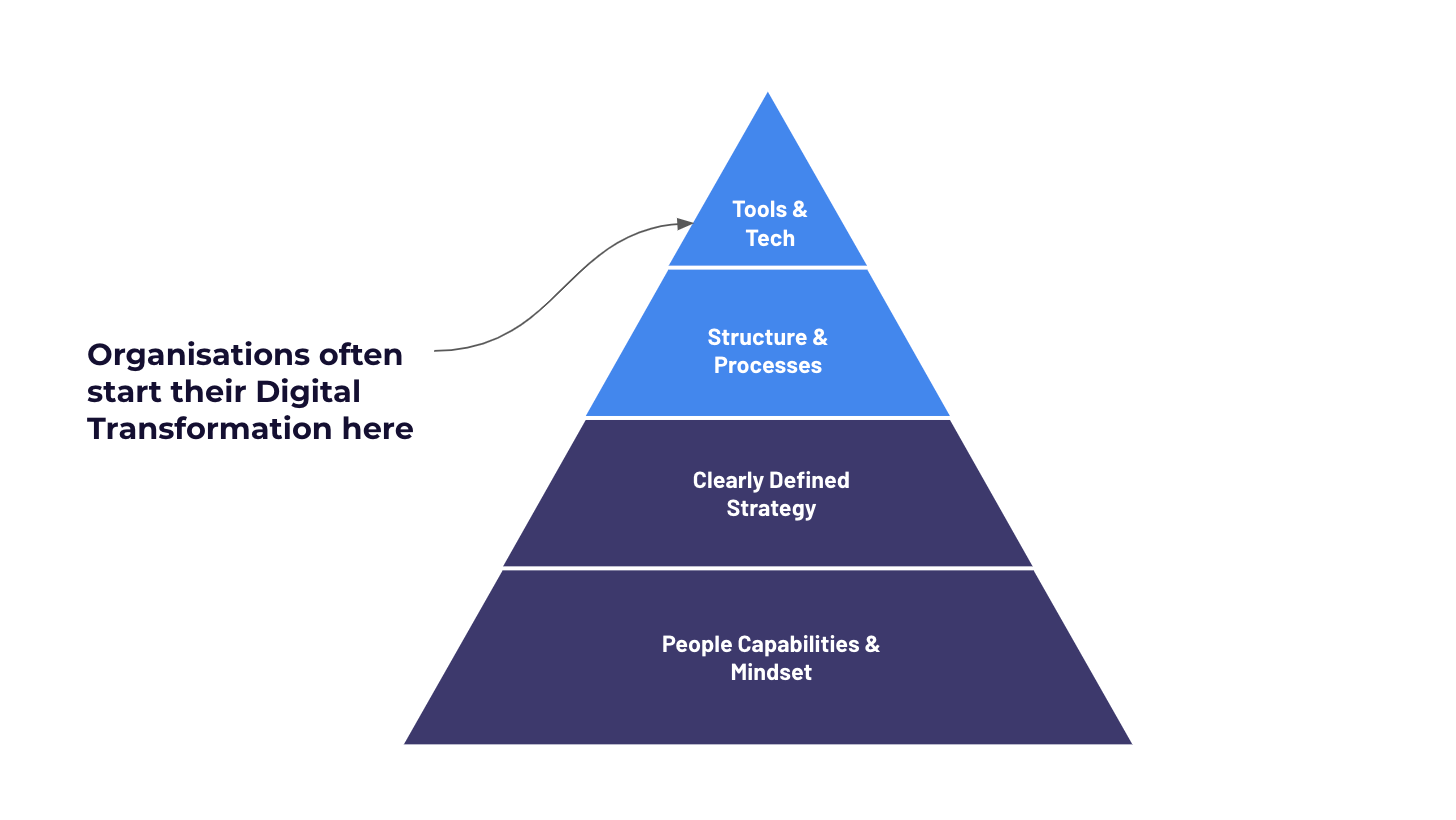
Tools and digital technology provide possibilities for efficiency gains and customer-centricity. But they rest on a foundation built out of people's capabilities, mindset and a clear strategy to integrate both.
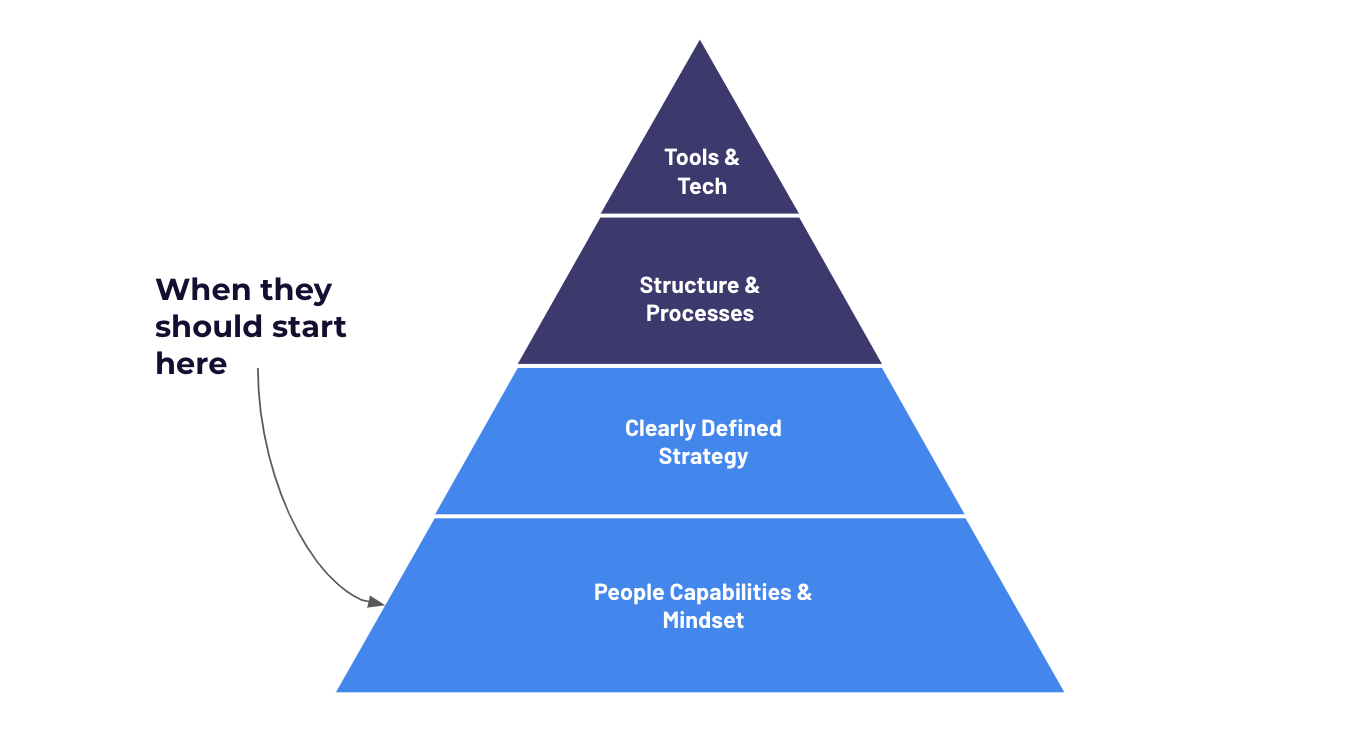
If we return to the average employee only spending 24 minutes a week for deliberate learning, we can begin to see where things go wrong. Only 1% of the average working week is spent on the highest ROI activity for your digital transformation.
The ROI of learning:
So why is learning the highest ROI activity? And why are you not spending more time and investment in learning and digital skills?
The facts show us that learning is serially overlooked:
- Less than 3% of Fortune 1000 companies have HR or L&D represented on the board. L&D simply doesn’t have a seat at the table.
- Midsize and large organisations (500-10k headcount) spend just €1065 per year per employee on employee learning and development.
- According to CEB research, only around 1 in 10 companies have a true learning culture, (that supports an independent quest for knowledge, and shared learning directed toward the mission and goals of the organisation)
- According to the same research, only 20% of employees demonstrate effective learning behaviours
- Most CEOs declare not knowing what the impact of learning efforts actually are.
The reason this happens often comes down to this. Below is a productivity pyramid, or as we like to call it, Return on Energy pyramid:
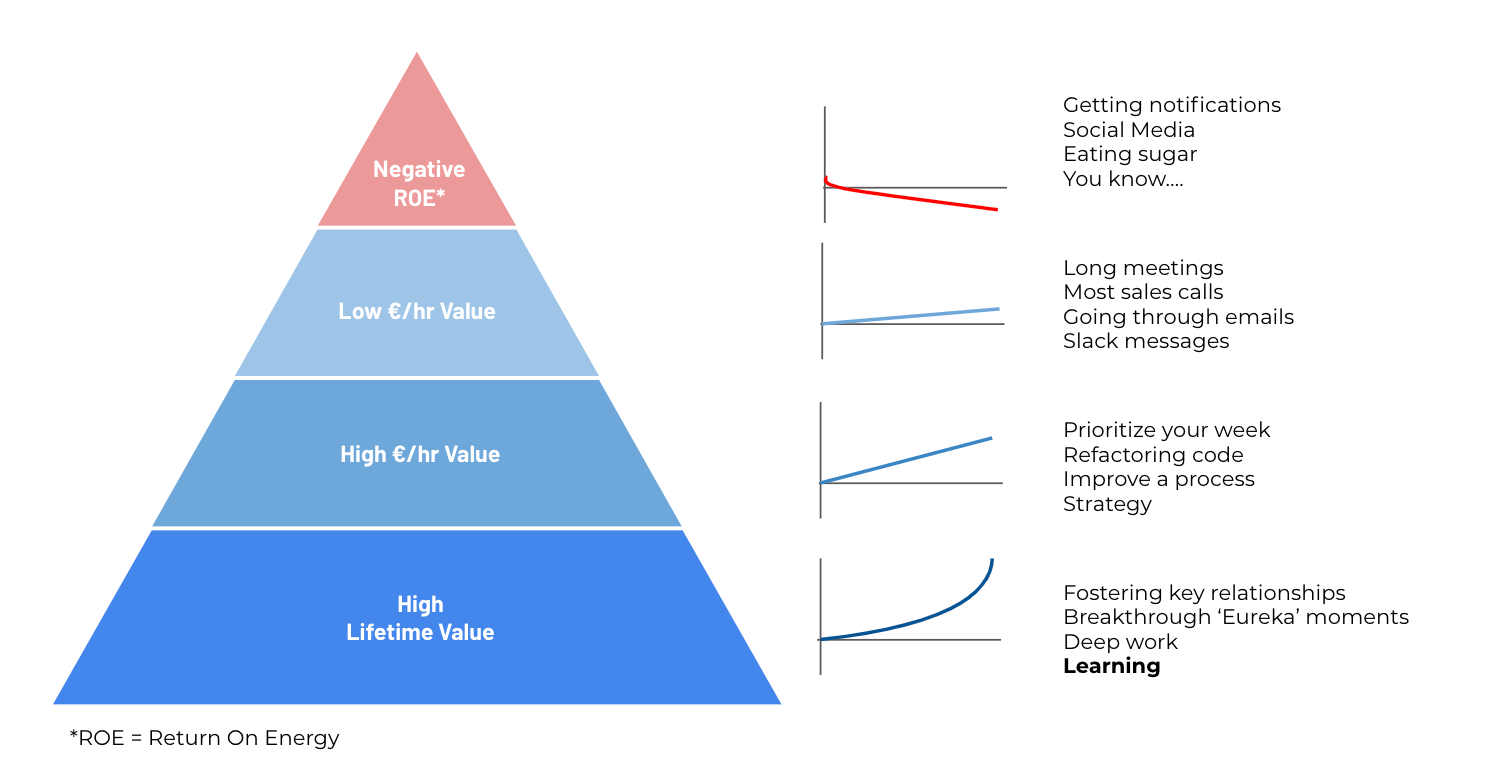
The pyramid breaks down a day, a week, month or year into 4 types of activities.
Based on the ROE of these activities. Or the Return on Energy of these activities.
You have limited time, limited energy, how are you using that time, that energy?
The top of the pyramid is what we call Negative ROE. Activities that have negative ROE are detrimental. This includes activities like scrolling on social media.
The second part is things that have positive ROE, but the ROE is low. A low hourly value. Things like long meetings or slack notifications.
Then there are high ROI activities, they have a high value per hour. And finally, there are the High LTV activities. Where you see the most gains, but often on a much longer time scale.
For example, actively fostering key relationships, breakthrough ideas - spending time to sit and think with no distraction. Activities that yield 0.01% of ideas that give 50% of returns. Moments of deep work, of learning.
So why do we underspend on learning?
The reason comes from the same cognitive bias that prevents us from taking action on most long term issues, like climate change, for example.
And that bias is called - temporal bias.
It is where we prioritise short term gain over long term gains. We tend to spend more energy on things that provide a quick return, over longer-term returns. Like answering emails, or the endless rounds of meetings. You get a quick feedback loop, but, as we are all aware, these are not the most productive activities on your week.
Those who can overcome this temporal bias, and prioritise the long term, win.
Why does learning have such a high ROI?
MIT and Deloitte’s recent study of digital transformation with 4300 executives researched the most successful, fast-growing, digitally transformed companies.
They found the most digitally transformed companies are differentiated by one thing: they've transformed the way individuals and organisations learn new capabilities.
And this means learning all the time, not just once a year.
Among these highest-performing companies:
- 73% of employees in these companies are updating their skills every six months and...
- 44% are updating them continuously.
In other words, today’s successful companies are those who learn fast, learn well, and learn all the time.
Another study by Pluralsight showed a return on investment of 295% on continuous learning. With payback seen in less than 6 months. The return was primarily delivered in faster, better product development due to faster talent development through upskilling and closing the digital skills gap.
It comes down to the fundamental fact that people and their day-to-day decisions are the foundation of any organisation.
And if every person can make decisions that are one or two per cent better every day, then the returns begin to compound and grow exponentially over time. Just like compound interest in the world of finance.
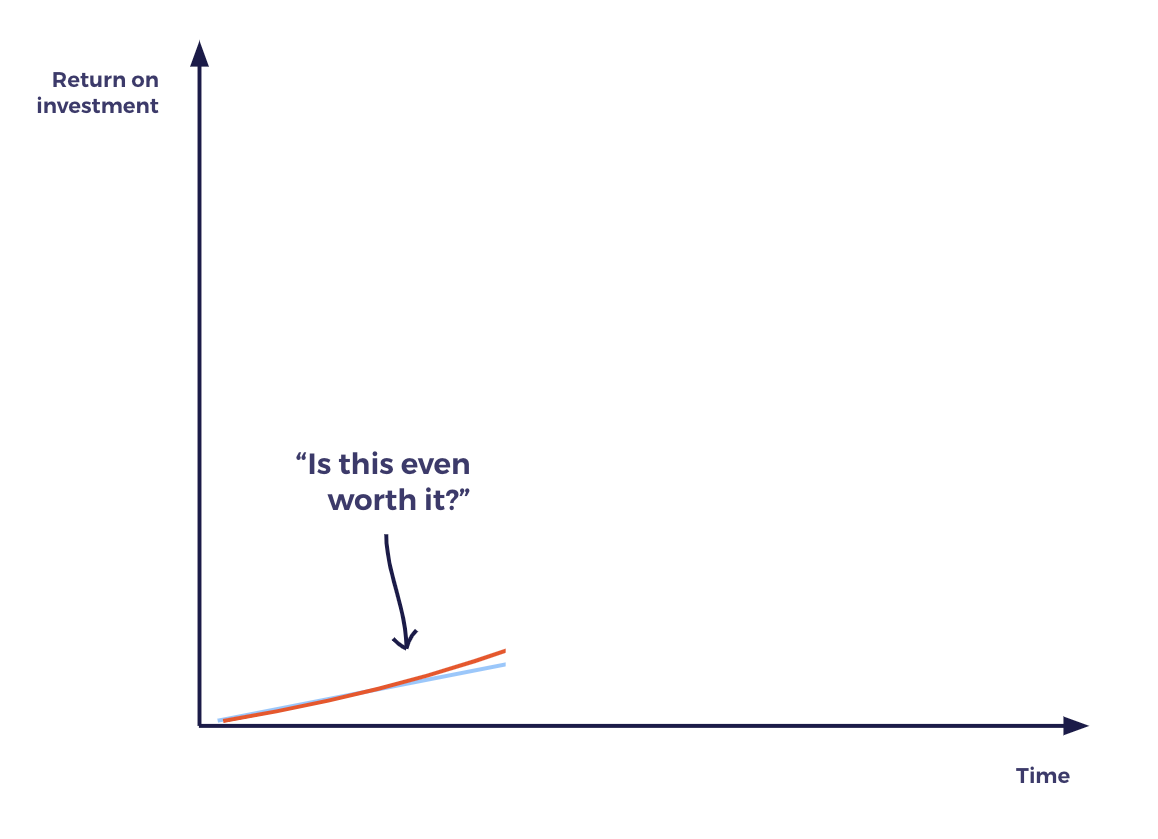
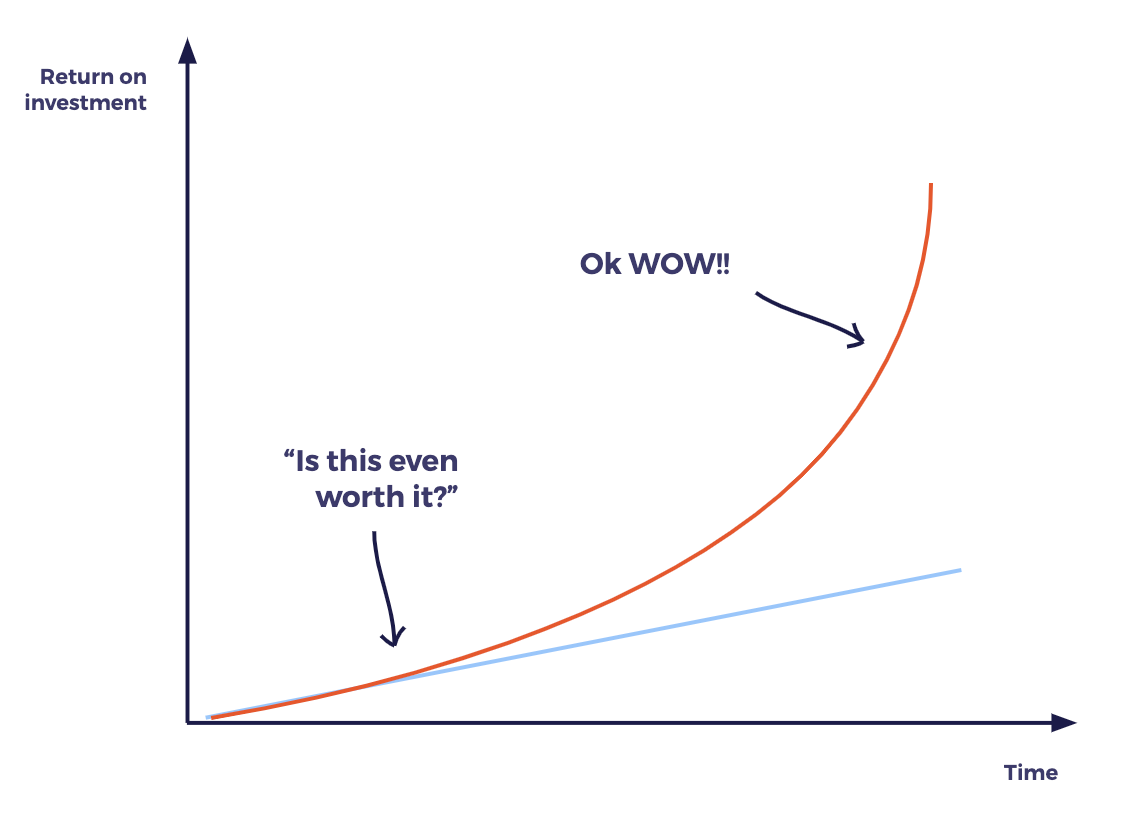
Human-CentricDigital Transformation Strategy

Human-Centric Digital Transformation Introduction
What is Human-Centric Digital Transformation?
Human-Centric Digital Transformation Definition
Digital Transformation is about People and Learning
Human-Centric Digital Transformation Strategy
Human-Centric Digital Transformation Framework
Human-Centric Digital Transformation Process - Running Experiments
Human-Centric Digital Transformation Examples
Human-Centric Digital Transformation Strategy
The anatomy of Digital Transformation
Imagine that an organisation is similar to a living organism. At the molecular, or cellular level, the organisation is made up of individuals. Of people.
While technology, tooling, strategies all form part of the structure of the organism, none of these is possible without the individual unit that underlies them all. People.
The talent, mindset, capabilities and skills of your people enable everything that follows, including digital transformation.
But, we don’t focus enough on learning & capabilities that allow for digital transformation to flourish in the many facets unique to your business. From new product development, services, business models, financial performance and more.
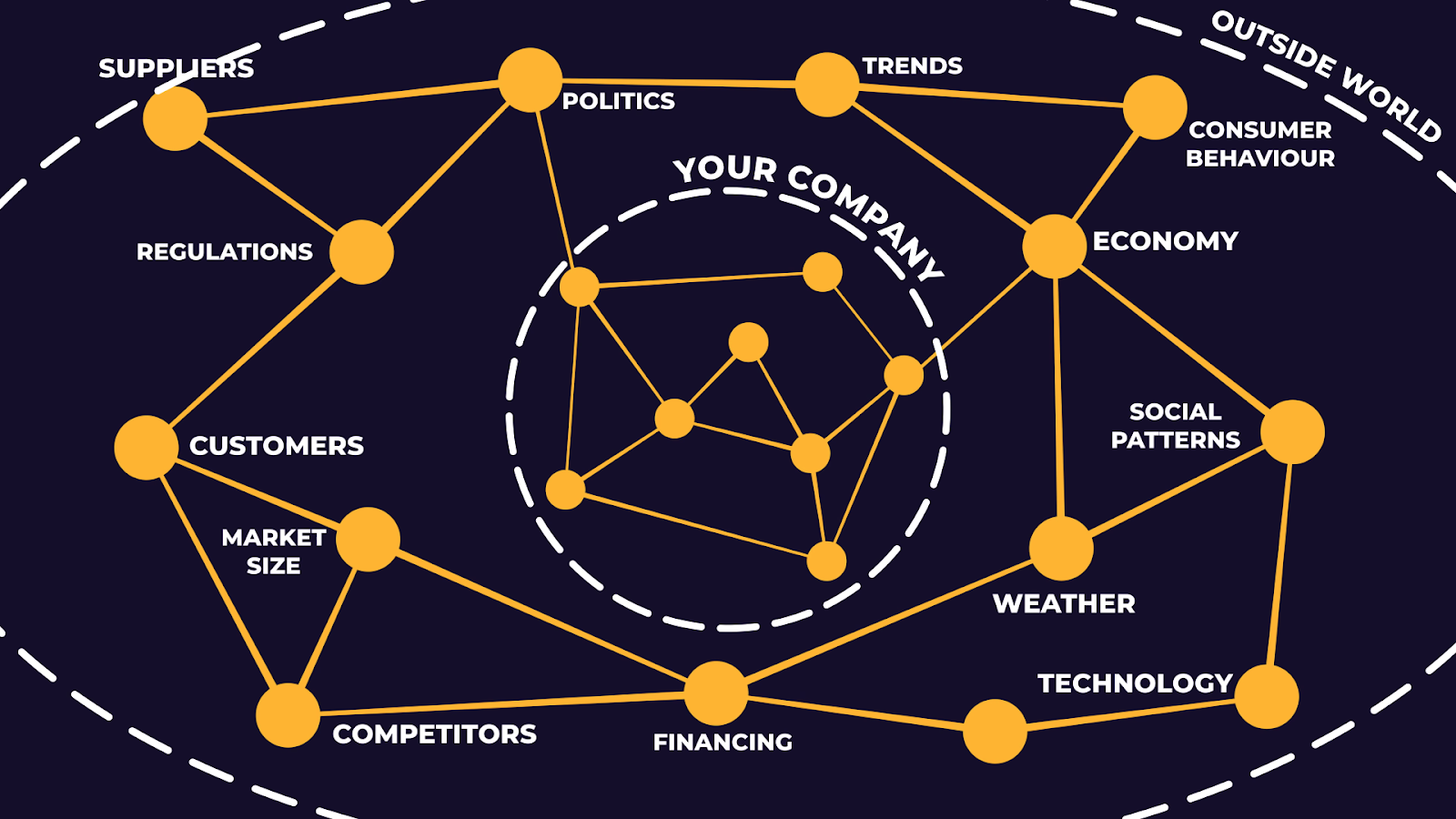
If we imagine a scenario where each component of your organisation, each human, was a lifelong, continuous learner capable of making better decisions based on superior and updated knowledge.
Creating an organisation, that, from the bottom up is self-learning and organically adapts and learns, digitally transforming over time.
That company becomes not only self-learning but also self-driving. It becomes an adaptable organisation that thrives on change.
Self-learning and self-driving organisations adapt better and faster within contexts in which they evolve. And right now, that is the era of digital transformation.
It’s not perfect, but it doesn’t need to be perfect, It just needs to be a bit better, a bit faster than your competitors. This is how evolution works.
Building a self-learning organisation to enable your Digital Transformation
Ultimately, while it is the individual who will be doing the learning required for digital transformation, it’s an organisation's role, and a leader's role to enable learning. To invest in learning and build capabilities.
There are, however, some blockers that you need to remove for your digital transformation through learning efforts to bear fruit.
Three blockers to remove:
- Having a fixed mindset vs. a Growth Mindset
A Growth Mindset is a concept studied and coined by Dr Carol Dweck over 30 years ago and closely studied at the organisational level through many research papers.
A Growth Mindset states we are and forever will be a “work in progress”. Whereas, the opposite of a Growth Mindset, a Fixed Mindset, believes that talent is innate and fixed.
For organisations, a lack of a Growth Mindset is evident at all levels, but generally lacking most in higher echelons, within organisational leadership. Where capabilities have perhaps decayed faster than we’d like to admit.
As a leader, it is important to ask questions and become conscious of what behaviour you are demonstrating as a leader? What type of culture are you fostering?
The key characteristics of a growth mindset team have been studied extensively, which one are you?
- Valuing status and a few key players?
Or,
- Your teams are built from individuals with wide-ranging potential, waiting to be unlocked?
- Rigid planning and control?
Or,
- An appetite for risk-taking and dealing with uncertainty?
- Are you more likely to hire from the outside (to ‘buy’ talent as we call it) and put an emphasis on past credentials and past accomplishments?
Or,
- Are you more likely to hire from within your own ranks and value potential, capacity, and a passion for learning?
How did you score? Mostly 1) Growth Mindset, or mostly 2) Fixed Mindset?
Are your personal capabilities up to speed with the modern digital world? Can you talk data, or understand the applications of Machine Learning. Can you design an experiment? This is the age of digital transformation, it’s time for us all to grow and learn.

We see two clear topic areas that are of increasing importance, and these are around data and digital channels. A Growth Mindset will help on the journey to understanding these and achieving your digital transformation.
2) The second blocker is typically time dedication and incentives to learn
The second blocker is typically time dedication and incentives to learn. In the face of popular myth, you don’t learn most of your new capabilities “on the job”.
You need to make deliberate time for learning.
Forward-thinking companies create time and actually invest in their people, invest in their learning.
Like AT&T’s company-wide reskilling program
Like Airbnb’s Analytics Academy
Or, like Philips University
These are big programs. But you can also start at the team level. Take your consulting budget, and turn it into a learning budget.
Learn to move faster, with more durable results and embed capabilities within the DNA of your teams.
In all of the above cases, leaders made dedicated time and budget available for learning.
And it’s a win, win!
A win for the business, and a win for the team members. Who feel valued and empowered.
3) The third obstacle, and possibly the biggest one of them all, is the paradox of choice.
Learning does not come with a manual.
Similar to when we go to the supermarket and the toothpaste aisle, we are confronted with a paradox of choice. Which one is the right one, which is the best?

The same goes for learning. What should you be learning next? And when?
We like to compare this to finding a diamond in a bag of broken glass. Luckily, we have sorted the diamonds from the glass so you don’t have to.
So, it is your responsibility as a leader to help answer this question. And in turn, it is our responsibility to help you answer that question too.
What should each function be learning next, and how deep should they go? This one is the hardest to solve.
We will give you some steps to implement to help you solve this very problem.
Stick with us and read on, it will be worth it!
Human-Centric
Digital Transformation Framework

Human-Centric Digital Transformation Introduction
What is Human-Centric Digital Transformation?
Human-Centric Digital Transformation Definition
Digital Transformation is about People and Learning
Human-Centric Digital Transformation Strategy
Human-Centric Digital Transformation Framework
Human-Centric Digital Transformation Process - Running Experiments
Human-Centric Digital Transformation Examples
Human-Centred Digital Transformation Framework
What should you be learning?
Capabilities need to achieve business goals, so you should start by asking what are your business goals? What metrics will be used to measure them? And therefore what capabilities/behaviours are required?
Of course, when it comes to what you should be learning for your digital transformation, the answer of course very much depends on the individual, the team and their function within your organisation.
Learning journeys are unique to individuals.
That being said, we recognise that there are some key capabilities and skills, particularly around data, digital skills and mindset.
We focus on:

Start with fast skills rather than slow skills.
Training is typically associated with soft skills like management training, communication and so forth.
But we recommend starting with FAST skills. Not that fast skills are more important than slow skills. However, slow skills are, well, slower to acquire and slower to show ROI.
With fast skills. you can start applying it the next day or week and have results within a sprint. Creating for a much better internal use case. And the beginnings of those compound returns come much sooner.
Start with consumer-facing teams: Customer Experience, Marketing, Data. You will get results faster.
Examples of FAST and SLOW skills:
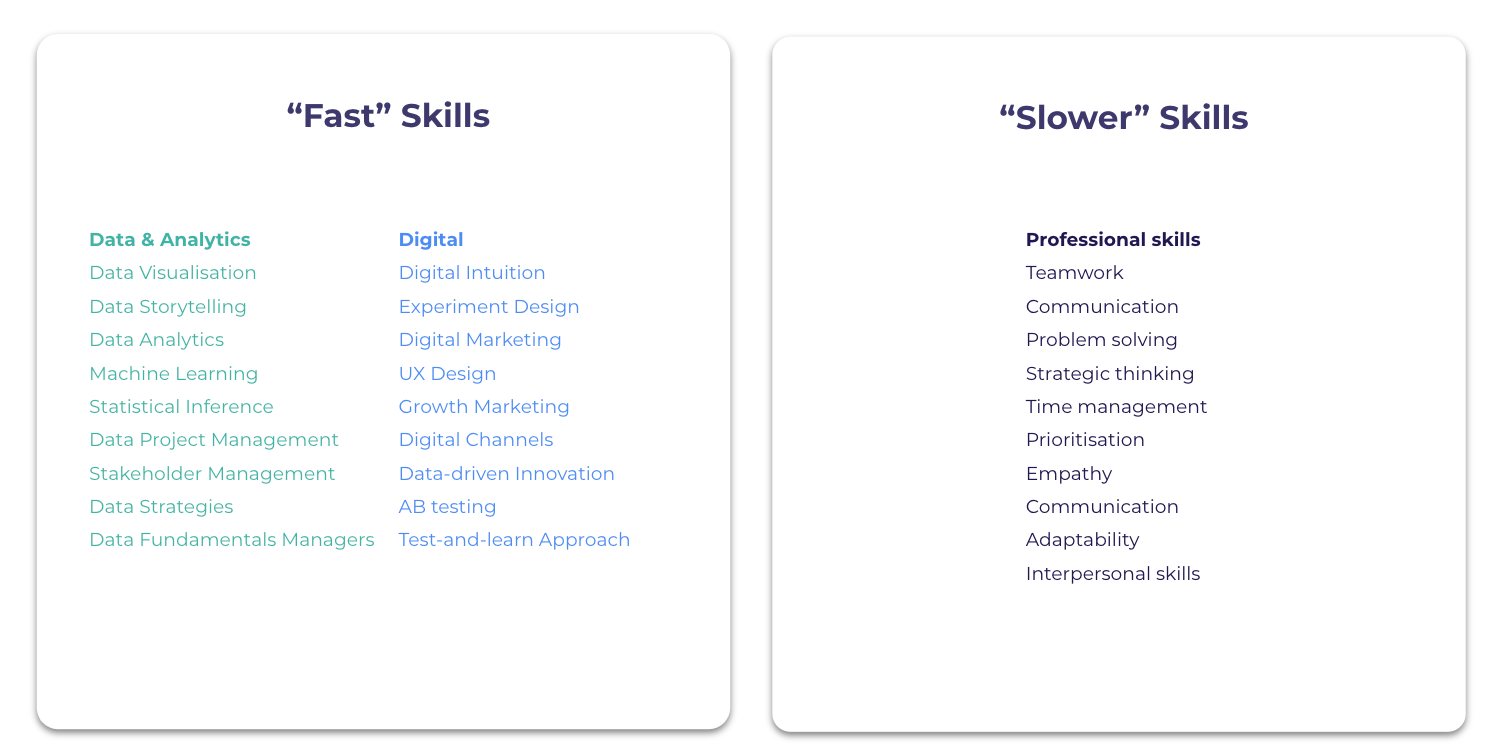
Measuring Capabilities for Digital Transformation
Run a Capability Scan for your Digital Transformation:
You wouldn't accept treatment from a Doctor without first getting diagnosed? You would expect some tests to be run, to have a consultation and examination before moving ahead with any form of treatment.
It is the same for your digital transformation learning programme. You need to first find out where the gaps are in your team’s capabilities, where the biggest needs are, as well as the strengths.
You can do just that, with something we call a CAPABILITY SCAN
We found in our research that nearly 1 in 6 organisations are not measuring skills at all, and those that do rely on consultants to tell them where they need skills and talent. Where is the sense in that? The best people to tell you what skills you need are, well, your people!
But we’ve built a tool that does this. It’s an assessment that delivers individual results as well as team results.
In the example below you can see a team, and the capabilities they have been measured against. Where individuals score, how the team scores as an average and the relative gap to be closed.
And you can do that across all important capabilities for your teams.

Of course, completing a capability scan requires quite some time and investment. But in the words of the world-renowned educator, author and consultant:
If you can’t measure it, you can’t change it.
Peter Drucker
You can try out a free version right now for managers of Data teams or Marketing teams:
What’s great here is you see where your strengths and weaknesses are, you can then double down on the strengths, and improve the weaknesses.
Give it a try.
Digital Transformation and T-Shaping skills:
Now that you know that fast skills are a quick win, and have measured skills and capabilities within your team, you have a path to change. To transform your people’s capabilities and become more digital, data-led and customer-centric, while fostering a Growth Mindset.
But, to set your organisation up for sustainable, long term digital transformation, you need to move towards T-Shaping the skills profiles of your people and teams.
Traditionally, hiring and talent have been based around either an I profile, individuals who are an expert in one area, or generalists who know a little about a lot of subjects.
T-Shaping, however, combines these two profiles. A T-Shaped professional is an expert in one subject matter and knowledgeable or skilled in a range of other areas too.
As you can see below, the vertical bar on the letter T represents the depth of knowledge in a specific capability, and the horizontal bar represents the breadth of knowledge across a range of disciplines.
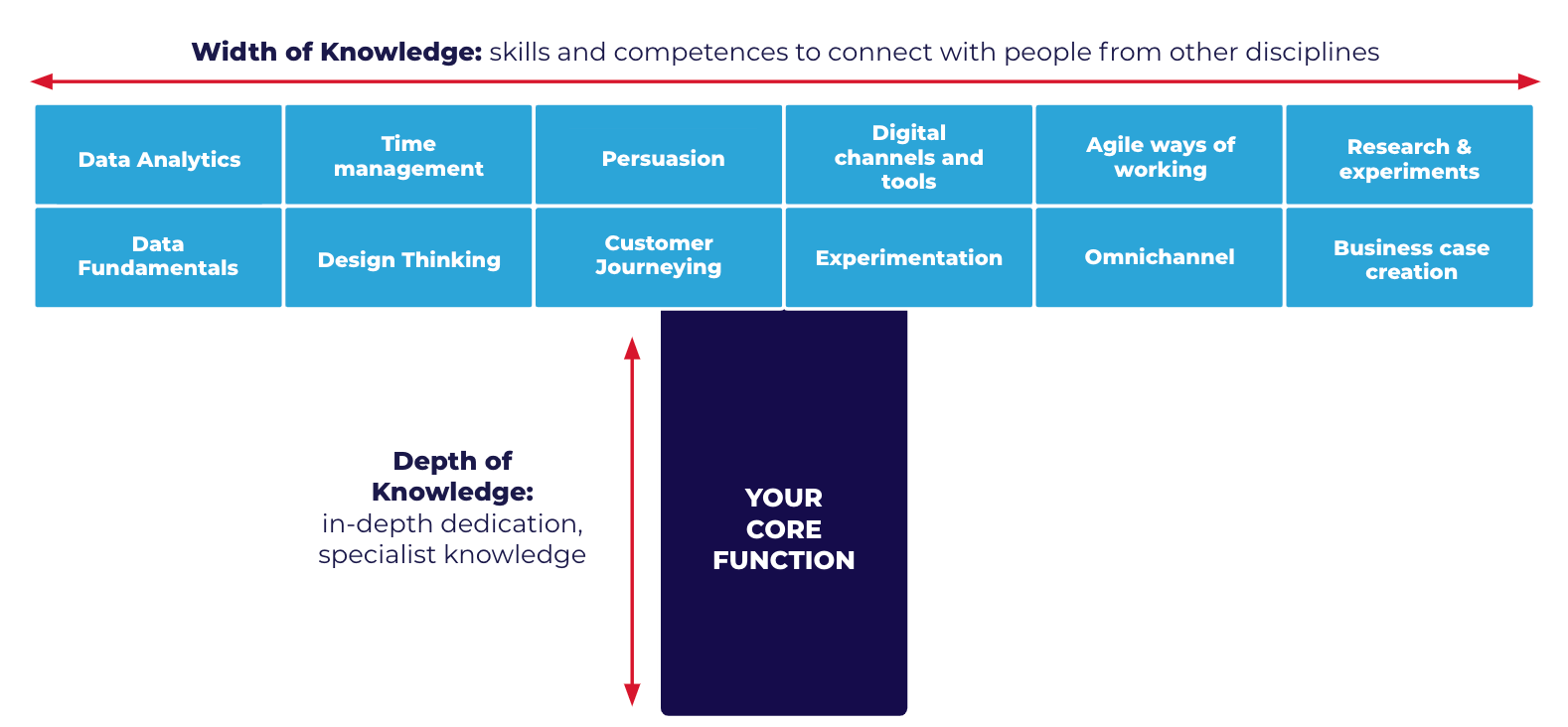
Why is this important? Essentially, T-Shaped people excel in their core function, but can also contribute to and perform other tasks effectively. And T-Shaped people can adopt a more end-to-end customer-centric approach.
As not every task in the workday requires an expert, non-expert tasks can be offloaded to T-Shaped team members. This frees up resources for experts to focus on tasks that need their attention to clear bottlenecks, while the team handles other tasks.
This cross-functional way of working means that you can do more with the same number of people, and come up with better solutions for the customer.
It also results in greater communication within a team, as everyone speaks the same language, with common understanding. And results in greater adaptability and agility. Essentially vital capabilities in the digital age and central to becoming antifragile.
Now you know where your team’s strengths and weaknesses lie, you can start cross-training and T-Shaping their skill profiles. As a result, this will open up any silos and increase the agility of employees, which improves your organisation's overall efficiency, and increases the likelihood of your digital transformation being successful.
Human-Centric Digital Transformation Process: Running Experiments

Human-Centric Digital Transformation Introduction
What is Human-Centric Digital Transformation?
Human-Centric Digital Transformation Definition
Digital Transformation is about People and Learning
Human-Centric Digital Transformation Strategy
Human-Centric Digital Transformation Framework
Human-Centric Digital Transformation Process - Running Experiments
Human-Centric Digital Transformation Examples
Human-Centric Digital Transformation Process: Running Experiments
Let’s Take Action:
Now you have the framework for digital transformation through learning, it’s time to take action and execute. We do this through experimentation. A rapid, small scale transformation, that tests and learns in an agile and adaptable way.
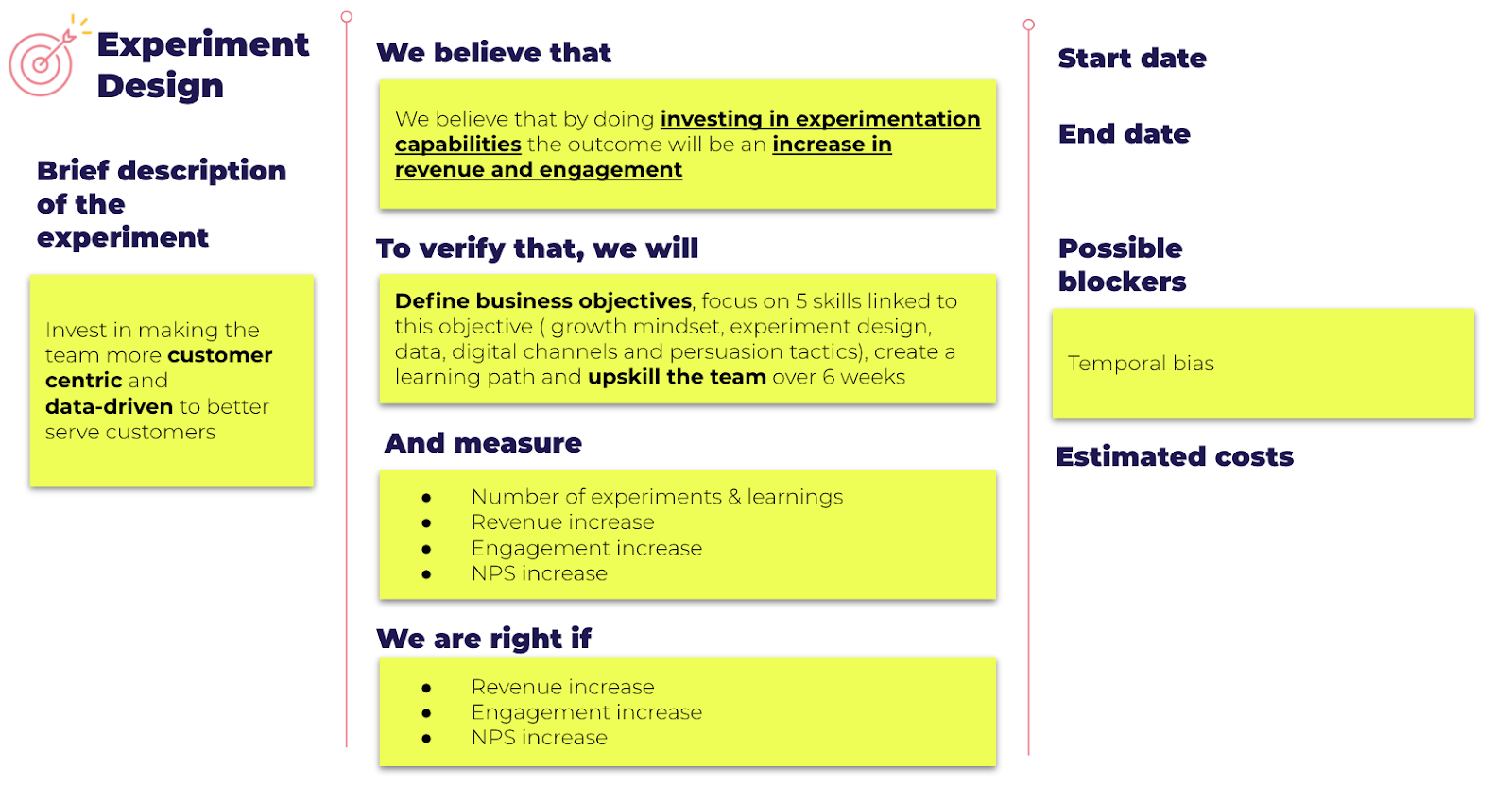
Think of it as a mini business case of sorts. So, for example, your experiment could be to invest more in making your team more customer-centric and data-driven to better serve your customers.
Using the experiment sheet above as your guide, follow these steps:
1) Write your hypothesis:
“I believe that by investing in experimentation, customer-centric and data capabilities, we can increase revenue and engagement on our product, X.”
2) Outline the business objectives:
To verify your hypothesis, you will need to then outline business objectives. Then, create a learning path and upskill the team over 6 weeks based on the skills that relate to your business objective.
3) Then, measure:
You can’t change anything you don’t measure. Here you should list the key KPIs linked to the business objectives. For example, a revenue increase, engagement increase, or whatever relevant KPIs are linked to the business objectives.
4) Define success by:
Outlining what the measures of success are. By asking yourself, “we are right if…”
Gather your learnings within the first month. If your revenue or engagement increase metrics increase by the defined amount, or you hit your KPI goals, your experiment will be deemed successful.
5) Consider blockers:
You can also think about what possible blockers might come, such as a lack of budget, or temporal bias.
This experiment card doesn’t need to be perfect but should provide the basis for you to experiment effectively and validate your hypothesis. Leading to greater customer-centricity, data-led ways of working, agile methodologies, or whatever outcomes are important for your business in its digital transformation.
Start with company objectives:
Another valuable exercise for your digital transformation through learning is to start with Company Objectives.
For example:
“Be more data-driven to increase profitability.”
Or,
“Be more customer-centric to drive engagement.”
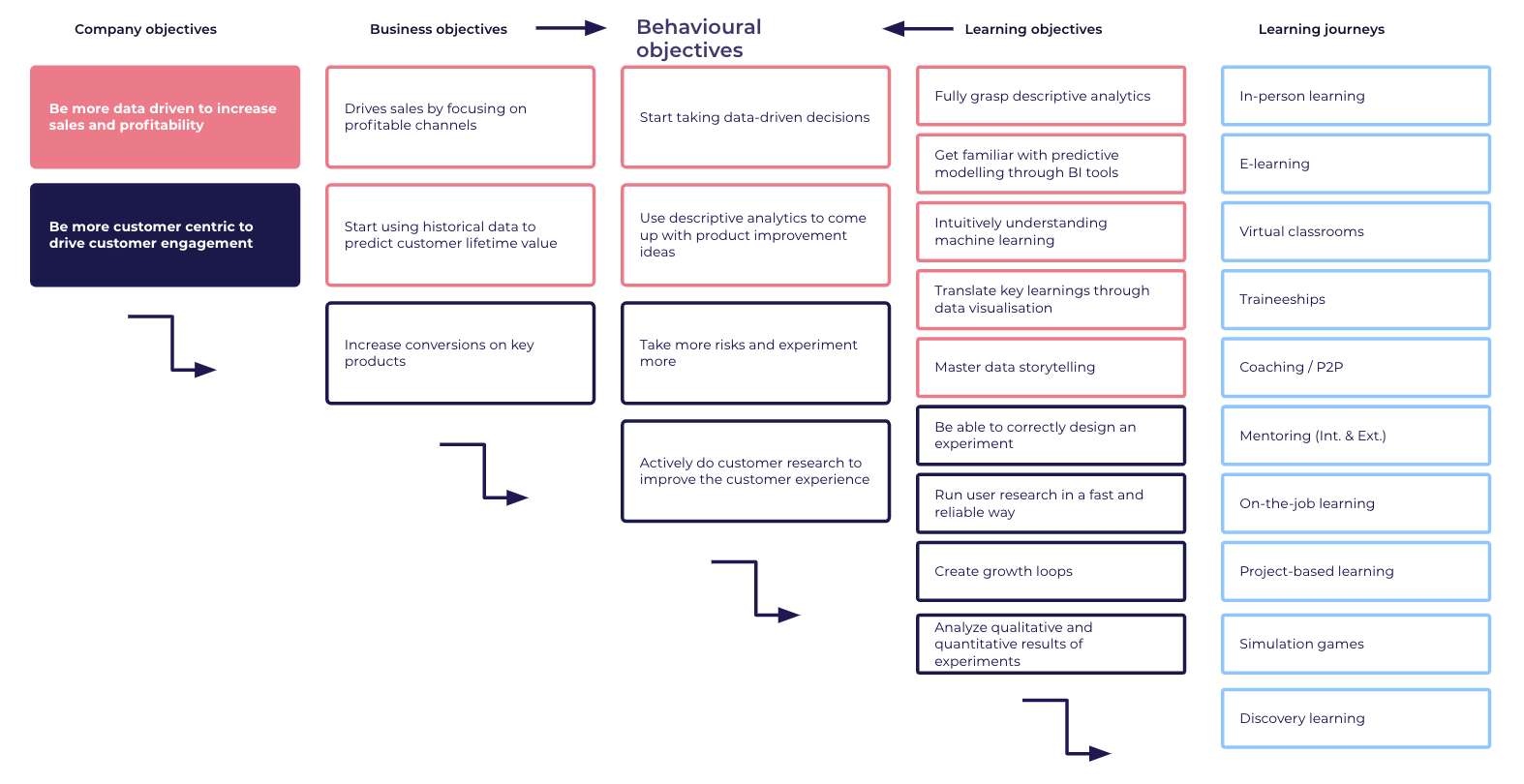
Typically, from your global strategy.
Then think about how those are linked to business objectives.
For being more data-driven it might be driving sales by focusing on profitable channels or using historical data to predict lifetime value.
For customer-centricity, it could be increasing conversions on key products.
Now comes the interesting part
How are your business objectives linked to BEHAVIOURS you’d like to see within the company?
Maybe you want people to start making more data-informed decisions (to have shorter meetings, less discussion and more insights). Or actively conduct better, faster user research, or maybe take more risks.
Then, think about how those behavioural objectives translate into Learning Objectives.
What could people learn to do better? For example, for being more data-led, having a stronger grasp of analytics, using BI tools, or getting better at data visualisation and data storytelling to communicate with other departments.
Or on becoming more customer-centric, knowing how to design an experiment, running user research, or analysing experiments.
Finally, the last part, and unfortunately the part organisations often begin with for digital transformation efforts. What tools/methods do you need to reach these learning and behavioural objectives?
And the sky’s the limit here, there’s so much available for learning:
- From in-person learning
- Online courses
- Coaching
- Mentoring
- Books
- Virtual classrooms
- Or a hybrid approach
This is how you can direct your digital transformation efforts through your business objectives, and start with people, skills and learning to unlock huge ROI.
Human-CentricDigital Transformation Examples

Human-Centric Digital Transformation Introduction
What is Human-Centric Digital Transformation?
Human-Centric Digital Transformation Definition
Digital Transformation is about People and Learning
Human-Centric Digital Transformation Strategy
Human-Centric Digital Transformation Framework
Human-Centric Digital Transformation Process - Running Experiments
Human-Centric Digital Transformation Examples
Human-Centric Digital Transformation Case Studies
Now you have the frameworks and understanding to achieve your digital transformation through learning, here are some examples of large organisations that have done just that.
Human-Centric Digital Transformation at AT&T
AT&T is a 133-year-old telecommunications company that is undergoing a massive digital transformation.
Moving from a legacy where they built the United States telegraph and telephone infrastructure, they face the mammoth challenge of updating from a voice network to a data network, from hardware to the cloud and from a landline business to a mobile-first enterprise.

Digital transformations don’t get much bigger than this. And the approach they are taking? Costing nearly $1 billion? By investing in their people, through a massive upskilling and reskilling programme.
In 2008, when AT&T leaders examined the skills they would need to thrive in this new mobile- and software-centric world, they faced a hard reality. The company just didn’t have enough of the talent that they needed.
With one of the largest workforces in the world, their research showed that only about half of their 250,000 employees had the necessary skills required.
And 100,000 workers were in jobs that wouldn't exist within the next decade.
Their approach?
As Bill Blase, senior executive vice president of human resources explained:
“We could go out and try to hire all these software and engineering people and probably pay through the nose to get them, but even that wouldn’t have been adequate. Or we could try to reskill our existing workforce so they could be competent in the technology and the skills required to run the business going forward.”
So that is exactly what they did.
Known inside the company as Future Ready, the initiative is a $1 billion multiyear effort that includes online courses; collaborations with learning providers and leading universities; and a career centre that allows employees to identify and train for the kinds of skills the company needs today and in the future.
An online portal allows employees to see available jobs, skills required, the potential salary and whether that particular skill set is projected to grow or decline in the future.
The results?
To date, the results are positive:
- 2.7 million online courses have been completed in areas such as data science, cybersecurity, agile project management and computer science.
- 177,000 virtual “badges” awarded to 57,000 employees on their internal career pages
- Those retrained are two times more likely to be hired into one of the newer, mission-critical jobs, and four times more likely to make a career advancement
- AT&T has reduced its reliance on outside consultants, as the talent is now internalised.
- AT&T has reduced its product-development cycle time by 40% and accelerated time to revenue by 32%
We’re moving from being a company where you learn a technology, become a subject-matter expert, and then you’re done, to one where we’re going to be learning something new all the time.”
AT&T Employee, Jacobie Davis
Human-Centric Digital Transformation at AirBNB
Airbnb, as a global tech success from Silicon Valley, may seem like a company that has little need for digital transformation. They already transformed an industry, right?
Yet, their inclusion here reiterates that digital transformation and learning is a continuous process, a work in progress that can always be improved.
Having scaled rapidly from the San Francisco area to 22 offices internationally, there were inherent challenges to such rapid growth in terms of ways of working and team skill sets.
Working in a data-led way was vital to the business, and with a team of 100 people working in Data Science, Airbnb wanted every employee to be empowered to leverage data to inform decisions. Not just the core data team.
They knew that access to the right tools and datasets was key. Yet, as they spoke to employees throughout Airbnb, it became more and more apparent that the bottleneck to scaling data-informed decisions was data education for users.
They realised that people and learning was the foundation of their data-led efforts.

The Solution? Airbnb Data University:
The issue wasn’t tools or tech, which they had in abundance. It was the skills to use those in the right way.
So, they created Data University, to enable a data education for anyone at Airbnb to become more data-informed.
Their vision? To empower every employee to make data-informed decisions.
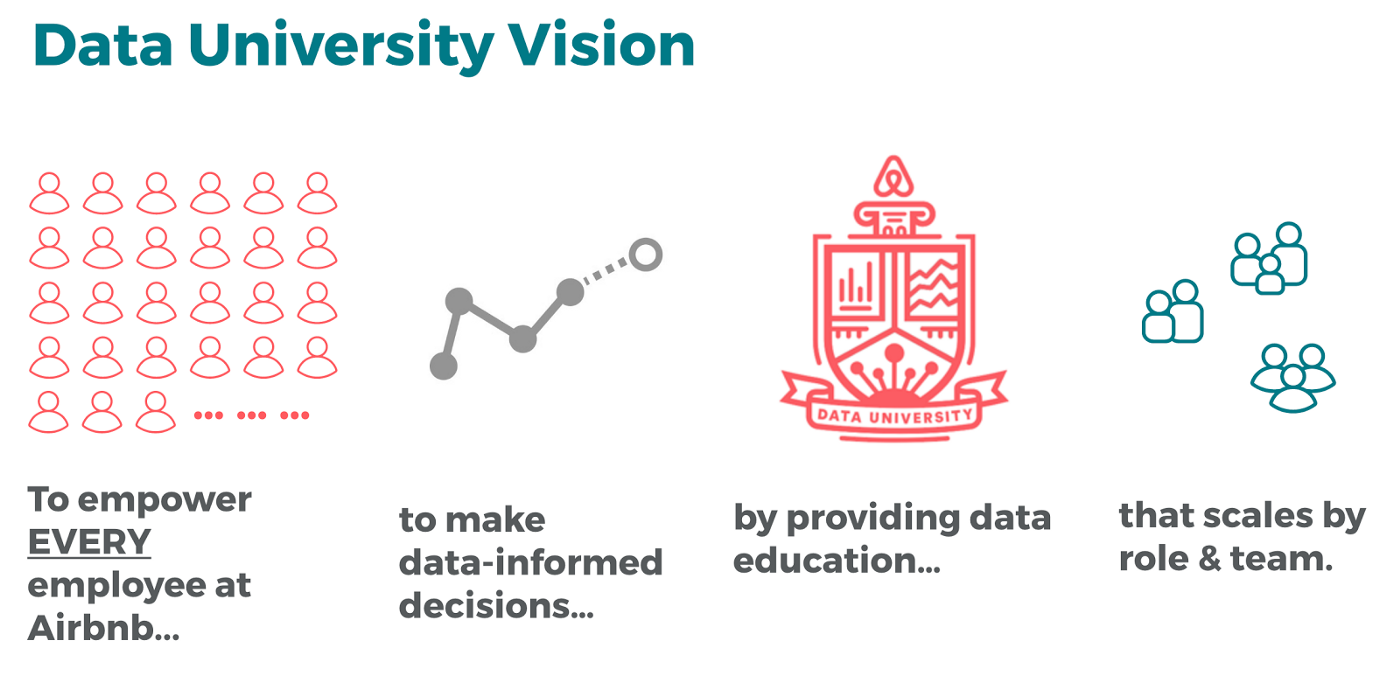
They believe that creating “citizen data scientists” is powerful. It helps ensure that decisions are based on data, but also enables employees to make decisions autonomously.
This reduces feedback loops and speeds up processes, as the person asking the questions always has the most context. Empowering them to solve that context autonomously has huge power for the business.
The Impact?
Data University has been a huge success so far at Airbnb.
In its first six months, more than 500 employees participated in at least one class (or about 1/8th of Airbnb). And employees are engaging deeply, taking on average four classes once they participate.
As a result, now 45% of Airbnb employees are actively working on Airbnb’s data platform every week! The culture of data is well and truly embedded.
How many companies can say that 45% of their workforce is using data so widely and regularly? From employees in recruiting creating Tableau dashboards to Product Managers writing their own SQL and interpreting their own experiments. Airbnb’s Data University has been a resounding success.